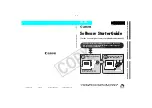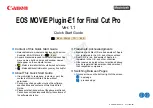
Using i!-ConnectLinx
4
i!-ConnectLinx
To specify the name of an action, send a command to the i!-ConnectLinx virtual device describing
the name of a given channel code. To specify the names of the actions in the above example, you
would add some code like this:
DATA_EVENT[vdvCLActions]
{
ONLINE:
{
(* Setup actions *)
(* VCR Play *)
SEND_COMMAND vdvCLActions,"'ADD ACTION-1,VCR Play"
(* VCR Stop *)
SEND_COMMAND vdvCLActions,"'ADD ACTION-2,VCR Stop' "
}
Once i!-ConnectLinx receives these commands, it stores this information in an XML file that can
be used by i!-ConnectLinx compatible technologies to browse available actions.
In addition to specifying the name of an action, you can also supply a help string and a folder name.
The help string helps a user understand the intent of the action more clearly. The folder name
allows you to organize the actions in a tree view so that actions are more easily browsed.
Standard Actions
So far, i!-ConnectLinx has handled custom actions where each action is likely to be different from
system to system. In the Using i!-ConnectLinx example, page 3, action 1 played the VCR.
However, in another system, it is very unlikely that action 1 plays the VCR.
i!-ConnectLinx uniquely identifies each action list. Once an i!-ConnectLinx compatible technology
programs itself to execute an action on a system, it also stores a copy of the system identifier from
the action list. This identifier is sent to i!-ConnectLinx along with this action execution request. If
the action identifier does not match the i!-ConnectLinx system that received the request, the action
is not executed. This eliminates the ambiguity that may exist, since each system’s action 1 may be
different.
i!-ConnectLinx supports standard actions. Standard actions are actions defined by AMX and
supported natively by i!-ConnectLinx. When adding actions to
i!-ConnectLinx, it is best to use the standard action if it is available. That way, the action can be
executed regardless of which system the i!-ConnectLinx compatible technology was programmed
to control.
The list of standard actions are listed in the
i!-ConnectLinxStdFunctionList.xls
file. The standard
actions ID are the same is the channel number used to execute the action. For instance, VCR Select
has an ID of
1011
so the programming to support this standard action is:
BUTTON_EVENT[vdvCLActions,1011] (* VCR Select *)
{
PUSH:
{
// Switch the projector and switcher to select the VCR
}
}
To add a standard action, look up the action ID in the Standard Function List file, and send that in a
send command to i!-ConnectLinx to tell it you want to support that action. To change the above
example to standard action:
1.
Lookup
VCR Play
and
VCR Stop
in the Standard Function List.
Continued


































